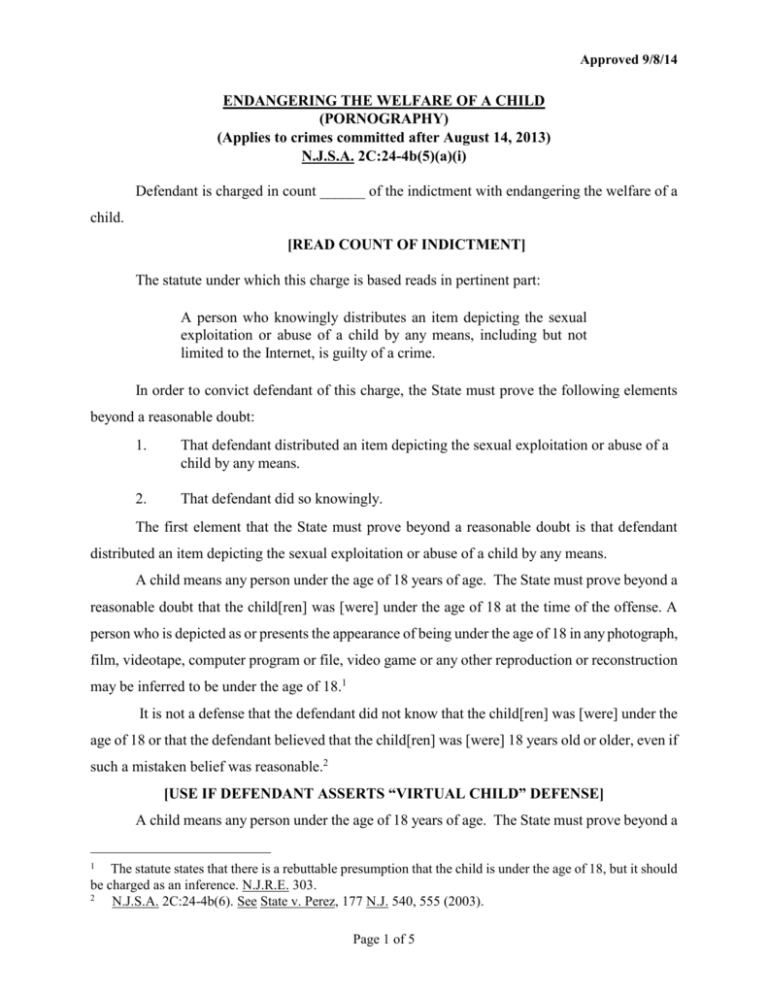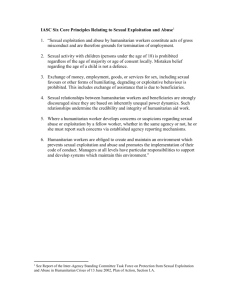
Approved 9/8/14
ENDANGERING THE WELFARE OF A CHILD
(PORNOGRAPHY)
(Applies to crimes committed after August 14, 2013)
N.J.S.A. 2C:24-4b(5)(a)(i)
Defendant is charged in count ______ of the indictment with endangering the welfare of a
child.
[READ COUNT OF INDICTMENT]
The statute under which this charge is based reads in pertinent part:
A person who knowingly distributes an item depicting the sexual
exploitation or abuse of a child by any means, including but not
limited to the Internet, is guilty of a crime.
In order to convict defendant of this charge, the State must prove the following elements
beyond a reasonable doubt:
1.
That defendant distributed an item depicting the sexual exploitation or abuse of a
child by any means.
2.
That defendant did so knowingly.
The first element that the State must prove beyond a reasonable doubt is that defendant
distributed an item depicting the sexual exploitation or abuse of a child by any means.
A child means any person under the age of 18 years of age. The State must prove beyond a
reasonable doubt that the child[ren] was [were] under the age of 18 at the time of the offense. A
person who is depicted as or presents the appearance of being under the age of 18 in any photograph,
film, videotape, computer program or file, video game or any other reproduction or reconstruction
may be inferred to be under the age of 18.1
It is not a defense that the defendant did not know that the child[ren] was [were] under the
age of 18 or that the defendant believed that the child[ren] was [were] 18 years old or older, even if
such a mistaken belief was reasonable.2
[USE IF DEFENDANT ASSERTS “VIRTUAL CHILD” DEFENSE]
A child means any person under the age of 18 years of age. The State must prove beyond a
1
The statute states that there is a rebuttable presumption that the child is under the age of 18, but it should
be charged as an inference. N.J.R.E. 303.
2
N.J.S.A. 2C:24-4b(6). See State v. Perez, 177 N.J. 540, 555 (2003).
Page 1 of 5
ENDANGERING THE WELFARE OF A CHILD (PORNOGRAPHY)
N.J.S.A. 2C:24-4b(5)(a)(i)
reasonable doubt that the [child][children] [was] [were] under the age of 18 at the time of the
offense. Moreover, the State must prove beyond a reasonable doubt that the images in question were
of [a] real [child] [children] and that defendant knew that the images were of [a] real
[child][children].3 A person who is depicted as or presents the appearance of being under the age of
18 in any photograph, film, videotape, computer program or file, video game or any other
reproduction or reconstruction may be inferred to be under the age of 18.4
It is not a defense that the defendant did not know that the [child][children] [was] [were]
under the age of 18 or that the defendant believed that the [child][children] [was] [were] 18 years old
or older, even if such a mistaken belief was reasonable.5
[RESUME MAIN CHARGE]
Distribute means to sell, or to manufacture, give, provide, lend, trade, mail, deliver, publish,
circulate, disseminate, present, exhibit, display, share, advertise, offer, or make available via the
Internet or by any other means, whether for pecuniary gain or not. It also includes an agreement6 or
attempt7 to distribute. The Internet means the international computer network of both federal and
non-federal interoperable packet switched data networks.
An item depicting the sexual exploitation or abuse of a child means a photograph, film,
video, an electronic, electromagnetic or digital recording, an image stored or maintained in a
computer program or file or in a portion of a file, or any other reproduction or reconstruction which
depicts a child engaging in a prohibited sexual act or in the simulation of such an act.8 Here, the
State alleges that the item was a (list item).
A prohibited sexual act means:
[CHOOSE APPROPRIATE]
sexual intercourse, which is penetration, however slight, of the vagina by a penis.9
anal intercourse, which is penetration, however slight, into the anus.10
3
State v. May, 362 N.J. Super. 572, 588 (App. Div. 2003).
The statute states that there is a rebuttable presumption that the child is under the age of 18, but it should be
charged as an inference. N.J.R.E. 303.
5
N.J.S.A. 2C:24-4b(6). See State v. Perez, 177 N.J. 540, 555 (2003).
6
If the State is alleging an agreement to distribute, the court should charge the jury on conspiracy.
7
If attempt is alleged, use the Model Jury Charge on Attempt.
8
See N.J.S.A. 2C:24-4b(1).
9
Hice v. State, 593 S.W.2d 57, 64 (Ark. 1980) and cases cited there.
10 State v. Gallagher, 286 N.J. Super. 1, 13 (App. Div. 1995), certif. denied, 146 N.J. 569 (1996).
4
Page 2 of 5
ENDANGERING THE WELFARE OF A CHILD (PORNOGRAPHY)
N.J.S.A. 2C:24-4b(5)(a)(i)
masturbation, which is stimulation of the genitals.11
bestiality, which is a sexual connection between a person and an animal.12
sadism, which is sexual gratification dependent largely on the infliction of pain on others.13
masochism, which is sexual gratification dependent largely on the infliction of physical or mental
abuse on the person.14
fellatio, which is oral contact with the male sexual organ.15
cunnilingus, which is oral contact with the female sex organ.16
nudity, if depicted for the purpose of sexual stimulation or gratification of any person who may view
such depiction.
vaginal intercourse, which is the penetration of the vagina, or [where appropriate] of the space
between the labia majora or outer lips of the vulva.17
sexual penetration, which is insertion of the hand, finger or object into the anus or vagina, either by
the defendant or on the defendant’s instructions.18
sexual contact, which is an intentional touching by the victim or defendant, either directly or through
clothing, of the victim’s or defendant’s intimate parts for the purpose of degrading or humiliating the
victim or sexually arousing or sexually gratifying the defendant.19
The second element that the State must prove beyond a reasonable doubt is that defendant
11
People v. Lamb, 90 Cal. Rptr.2d 565, 576 (Ct. App. 1999).
State v. Bonynge, 450 N.W.2d 331, 338 (Minn. Ct. App. 1990).
13 Ex Parte Anderson, 902 S.W.2d 695, 700 (Tex. Ct. App. 1995).
14 Id. at 700.
15 State in the Interest of S.M., 284 N.J. Super. 611, 616-19 (App. Div. 1995).
16 State v. Fraction, 206 N.J. Super. 532, 535-36 (App. Div. 1985), certif. denied, 104 N.J. 434 (1986).
17 See State v. J.A., 337 N.J. Super. 114 (App. Div. 2001). The Appellate Division upheld the charge given
by the trial court in that case which included the following language which can be used if the circumstances of
the specific case are appropriate: “This means that if you find from all of the evidence presented beyond a
reasonable doubt that there was [penile] penetration to the outer area of the vaginal opening, what is commonly
referred to as the vaginal lips, that is sufficient to establish penetration under the law.”
18 N.J.S.A. 2C:24-4b(1)(j) refers to “[a]ny act of sexual penetration or sexual contact as defined in N.J.S.
2C:14-1.” Every other act of “penetration” referred to in N.J.S.A. 2C:14-1, except for vaginal intercourse, is
set forth in the definition of prohibited sexual act.
19 N.J.S.A. 2C:14-1d. See State v. J.A., 337 N.J. Super. 114 (App. Div. 2001). The Appellate Division
upheld the charge given by the trial court in that case which included the following language which can be
used if the circumstances of the specific case are appropriate: “This means that if you find from all of the
evidence presented beyond a reasonable doubt that there was [penile] penetration to the outer area of the
vaginal opening, what is commonly referred to as the vaginal lips, that is sufficient to establish penetration
under the law.”
12
Page 3 of 5
ENDANGERING THE WELFARE OF A CHILD (PORNOGRAPHY)
N.J.S.A. 2C:24-4b(5)(a)(i)
acted knowingly. A person acts knowingly with respect to the nature of his/her conduct or the
attendant circumstances if he/she is aware that the conduct is of that nature or that such
circumstances exist or the person is aware of a high probability of their existence. A person acts
knowingly with respect to a result of the conduct if he/she is aware that it is practically certain that
the conduct will cause a result. “Knowing,” “with knowledge,” or equivalent terms have the same
meaning.
Knowledge is a condition of the mind. It cannot be seen and can only be determined by
inference from defendant’s conduct, words or acts. A state of mind is rarely susceptible of direct
proof but must ordinarily be inferred from the facts. Therefore, it is not necessary that the State
produce witnesses to testify that an accused said that he/she had a certain state of mind when he/she
did a particular thing. It is within your power to find that such proof has been furnished beyond a
reasonable doubt by inference which may arise from the nature of his/her acts and conduct and from
all he/she said and did at the particular time and place and from all surrounding circumstances
established by the evidence.
If you find that the State has proven each element beyond a reasonable doubt, then you must
find defendant guilty. If you find that the State has failed to prove any element beyond a reasonable
doubt, then you must find defendant not guilty.
[CHARGE THE FOLLOWING IF THE STATE ALLEGES THAT THERE WERE 25 OR
MORE ITEMS DEPICTING THE SEXUAL EXPLOITATION OR ABUSE OF A CHILD]
If you have found defendant guilty of the offense, you must go on to decide whether the State
has proven beyond a reasonable doubt that defendant distributed 25 items or more depicting the
sexual exploitation or abuse of a child. Each depiction of the sexual exploitation or abuse of a child
is considered a separate item and each individual distribution of an item depicting the sexual
exploitation or abuse of a child is considered a separate item, whether the act or acts of distribution
were to the same person or several persons or occurred at different times20 (so long as each
individual act was committed during the statute of limitations).
If you find that the State has proven beyond a reasonable doubt that there were 25 or more
20
The statute requires that these acts for aggregation purposes occur within the applicable statute of
limitations. If this is an issue, the jury charge should indicate that the jury is to find that the acts occurred
within a specified period of time.
Page 4 of 5
ENDANGERING THE WELFARE OF A CHILD (PORNOGRAPHY)
N.J.S.A. 2C:24-4b(5)(a)(i)
items depicting the sexual exploitation or abuse of a child, then you must answer “yes” on the verdict
sheet. If you find that the State has failed to prove beyond a reasonable doubt that there were 25 or
more items or more depicting the sexual exploitation or abuse of a child, then you must answer “no”
on the verdict sheet.
Page 5 of 5







